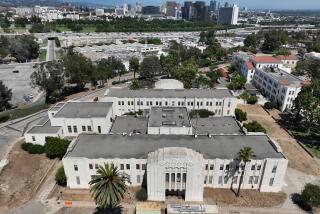Suburbia Marches on Civil War Battlefield
- Share via
CHANCELLORSVILLE, Va. — There are no shops here. No hotels, no restaurants, no malls. Around one of the Civil War’s most historically significant battlefields, there is no road to a frappuccino or Victoria’s Secret.
But suburbia is banging on this battlefield’s door.
A national fight over just how much development can bump up against Civil War battlegrounds is erupting here, on the land where Confederate Gen. Thomas “Stonewall” Jackson died, where one of history’s most famous surprise attacks occurred, where Robert E. Lee’s troops scored a stunning and improbable victory.
Plans to build what one developer calls the new “town of Chancellorsville” near the historic killing ground promises to bring in roughly 6,000 residents, several big-box stores, four hotels, a library, a skating rink, a movie theater and more.
And with those plans, laid out on colorful story boards and awaiting action this month by the Spotsylvania County Board of Supervisors, comes what preservationists call the biggest threat to any Civil War battlefield today -- to destroy the land where one of Virginia’s bloodiest battles took place.
“We’ve got to fight this one to the death,” said James Lighthizer, president of the Civil War Preservation Trust, a national nonprofit organization.
“There’s plenty of other places to put these gargantuan developments -- not here,” he added, gazing from the ridge that Union troops fled in May 1863. He predicted an onslaught of traffic and sprawl if the new town is approved.
The fight to protect Chancellorsville, just west of Fredericksburg and almost midway between Washington and Richmond, is part of a national effort to preserve battlefield land.
And for that there is no better testing ground than Spotsylvania County and its environs, where 100,000 men died in four major battles during the war: Fredericksburg, Chancellorsville, the Wilderness and Spotsylvania Courthouse.
Some local officials, noting that Spotsylvania is one of Virginia’s fastest-growing counties, argue that if they tiptoed around all the land that Civil War armies fought over, none of the property in the county would be developed.
“Somewhere or another, an army passed through Spotsylvania County and people died,” said the county’s administrator, Anthony Barrett.
The controversial development would be built on a dairy farm up for sale -- land adjacent to the Chancellorsville battlefield, of which 1,600 acres are federally protected as a national military park.
Although combat occurred on a piece of the farm’s 790 acres, preservationists place greater value on what did not happen there: The absence of development on the land since the Civil War has indirectly helped preserve the battlefield’s sight lines and rural character.
Now the county is considering rezoning the property to allow for 10 times the houses that could otherwise be built there and four times the business development: That’s 2,350 homes and 2.4 million square feet of commercial space.
Ray Smith, a northern Virginia developer who hopes to build the new town, argues that if the land were so important, preservationists would have bought it two years ago when its owner, undertaker John Mullins, put it up for sale.
Preservationists contend that they were not given enough time to assemble a bid for the property, which they say carried an $18-million price tag. Now they are trying to persuade local officials to deny the new zoning or, better yet, persuade the federal government to buy the land and make it part of the park.
So far, the state government is sitting on the sidelines.
Smith, noting that a four-lane highway already runs by the Chancellorsville battlefield, insists that, like it or not, a tide of development is coming.
“You can’t just take away people’s property rights,” argued Smith, whose Dogwood Development Group holds an option on the property. “This is still America. That’s one of the freedoms people fought for in that Civil War.”
The three-day Battle of Chancellorsville is known to historians for a maneuver so bold that Winston Churchill came to study it, military students still analyze it and Gen. H. Norman Schwarzkopf called it a model for his Gulf War tactics.
Although the North outnumbered the South more than 2-to-1 at Chancellorsville, Stonewall Jackson, under Lee’s command, gambled and led his men on a 12-mile march along largely hidden wooded trails, sneaking up on the North’s right flank and routing the unsuspecting Union troops.
About 7,500 men died -- including Jackson, who was mistakenly shot by Confederate sentries.
Lee saw his victory at Chancellorsville as evidence of the Confederacy’s might: Two months after that battle, in what some historians view as a fatal miscalculation, an emboldened Lee pushed into Union territory, moving through Maryland and into Pennsylvania only to suffer defeat at Gettysburg. The Confederacy never recovered.
“If this development is built, it would be a tragedy for American history,” said Robert Krick, a former Park Service historian and an authority on Chancellorsville.
“It would enrich a few people a great deal right now and hurt a lot more in the future.”
Preservationists worry that the battlefield will go the way of Salem Church, a Civil War landmark that sits amid the strip malls of nearby Fredericksburg. The church offers a view of a drugstore and absorbs the exhaust from 10 lanes of traffic.
There is a reason for all this commercial activity: The Spotsylvania area is attracting new waves of commuters looking for affordable homes and ready access to Interstate 95.
Champions of the Chancellorsville development say the state has plans for an inter-county highway that would run through the area near the battlefield, making construction inevitable regardless of the wishes of the preservationists.
But critics say the unfunded highway project might never get built, and Virginia’s budget problems are not likely to speed up decisions about the road’s future.
Lighthizer, a former Maryland transportation secretary, fears that local officials will be swayed by the developer’s promises of economic growth.
“It’s a lack of sophistication -- you see that in rural counties a lot around the country,” he said. “This is not smart growth -- this is dumb growth.”
In his Reston office, with a view of Northern Virginia sprawl from nine floors up, Smith describes how his new village would respect history.
The developer said he would create a 34-acre battlefield park in the corner of the property where fighting occurred. Cannons, statues, maps and military plaques would be placed around the town.
Smith contends that residents would not overload roads because all their jobs, shops and byways would be inside the bubble of his community -- a notion that preservationists call laughable.
But critics recognize the allure of Smith’s bottom-line argument: The development would enhance the local tax base, attract new waves of tourists and make the battlefield more popular than ever.
“Who are these elitists trying to save this battlefield for if not for Americans coming to visit?” Smith asked.
More to Read
Sign up for Essential California
The most important California stories and recommendations in your inbox every morning.
You may occasionally receive promotional content from the Los Angeles Times.













